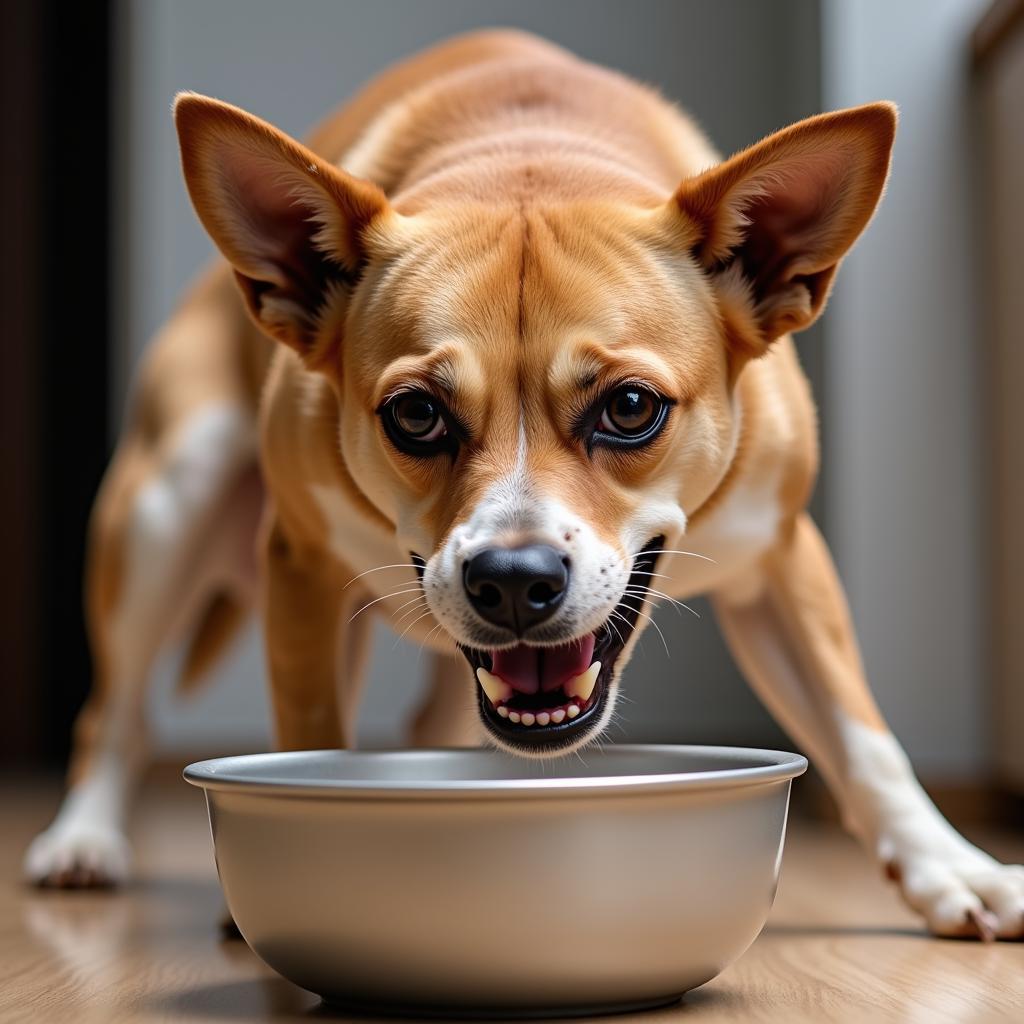Food aggression in dogs towards other dogs is a common behavioral issue that can be challenging for owners. It stems from a dog’s instinct to protect valuable resources, in this case, food. This possessiveness can manifest as growling, snapping, or even biting when another dog approaches while they are eating. Addressing this problem is crucial for ensuring the safety of other pets and people in the household.
Why Does Food Aggression Occur?
Several factors can contribute to food aggression. Resource guarding is a natural instinct in dogs, stemming from their ancestral need to protect food from competitors. This instinct can be heightened in dogs who have experienced food insecurity, such as strays or those from shelters. Early socialization also plays a crucial role; dogs who haven’t been properly socialized with other dogs around food may be more prone to guarding their meals. Additionally, genetics and learned behaviors can influence the likelihood of food aggression.
Recognizing the Signs of Food Aggression
Identifying the subtle signs of food aggression is essential for early intervention. These can include stiffening of the body, whale eye (showing the whites of their eyes), lip curling, growling, and air snapping. In more severe cases, dogs may escalate to biting. Even seemingly minor displays of aggression should be taken seriously.
 Dog showing food aggression signs, including stiff body, whale eye, and lip curling
Dog showing food aggression signs, including stiff body, whale eye, and lip curling
Managing and Preventing Food Aggression
Dealing with food aggression requires patience and consistency. One effective strategy is to create a safe and separate feeding area for each dog, minimizing the chance of competition. Gradually desensitize your dog to the presence of other dogs near its food bowl by starting with a significant distance and slowly decreasing it over time. Rewarding calm behavior with high-value treats can reinforce positive associations.
Training Techniques to Address Food Aggression
Several training techniques can help mitigate food aggression. “Trade-up” exercises, where you offer a more desirable treat in exchange for the food they’re guarding, can teach your dog that the approach of another dog or person isn’t a threat. Hand-feeding can also help build trust and positive associations with food. Positive reinforcement methods, focusing on rewarding desired behavior rather than punishing aggression, are generally the most effective.
When to Seek Professional Help
If your dog’s food aggression is severe or you’re struggling to manage it, seeking professional guidance from a certified dog trainer or veterinary behaviorist is crucial. They can assess your dog’s specific situation and develop a tailored training plan.
 A certified dog trainer using positive reinforcement methods to address food aggression in a dog
A certified dog trainer using positive reinforcement methods to address food aggression in a dog
Preventing Food Aggression in Puppies
Early socialization is key to preventing food aggression in puppies. Expose them to various situations involving food and other dogs from a young age. Supervise mealtimes with multiple puppies and ensure each has enough space and access to food. This helps them learn to eat without feeling the need to guard their resources.
The Importance of a Balanced Diet
While not directly causing food aggression, a balanced diet contributes to a dog’s overall well-being and can indirectly influence behavior. Nutritional deficiencies can sometimes lead to increased anxiety and stress, which might exacerbate existing behavioral issues.
“A nutritionally complete and balanced diet is essential for a dog’s physical and mental health, contributing to a calmer and more balanced demeanor,” says Dr. Emily Carter, DVM, a certified veterinary behaviorist.
Conclusion
Addressing food aggression in dogs towards other dogs requires a multi-pronged approach involving management, training, and sometimes professional intervention. Understanding the underlying causes, recognizing the signs, and implementing effective strategies can create a safer and more harmonious environment for all pets in the household. By proactively addressing this issue, you can ensure that mealtimes become a positive experience for everyone. Remember, patience and consistency are key to success in overcoming food aggression.
FAQ
- What is the most common sign of food aggression in dogs? Growling or snapping when another dog approaches their food.
- Can food aggression be cured? While not always completely “cured,” it can be effectively managed and significantly reduced through proper training and management techniques.
- Should I punish my dog for food aggression? Punishment is generally ineffective and can worsen the problem. Focus on positive reinforcement methods instead.
- How long does it take to address food aggression? The timeline varies depending on the severity of the aggression and the dog’s individual response to training.
- Is professional help necessary for food aggression? If the aggression is severe or you are struggling to make progress, consulting a professional trainer or behaviorist is highly recommended.
- Can food aggression develop in older dogs? Yes, although it’s more common in puppies and younger dogs, changes in environment or health can trigger food aggression in older dogs.
- How can I prevent food aggression in a multi-dog household? Feed dogs in separate areas, ensure each dog has enough food, and supervise mealtimes closely.
“Early intervention is crucial in addressing food aggression. The sooner you address the issue, the easier it is to modify the behavior,” adds Dr. Carter.
Need more help? Check out our other articles on dog behavior and training. For personalized support, contact us: Phone: 02437655121, Email: minacones@gmail.com Or visit us at: 3PGH+8R9, ĐT70A, thôn Trung, Bắc Từ Liêm, Hà Nội, Việt Nam. We have a 24/7 customer support team.